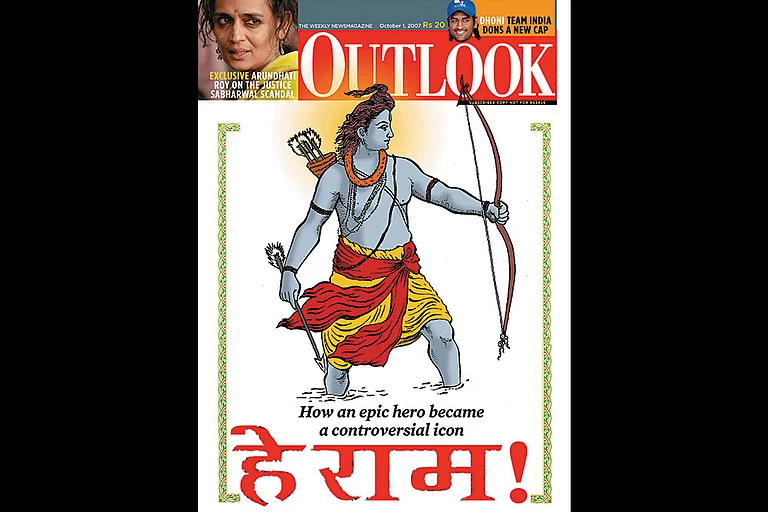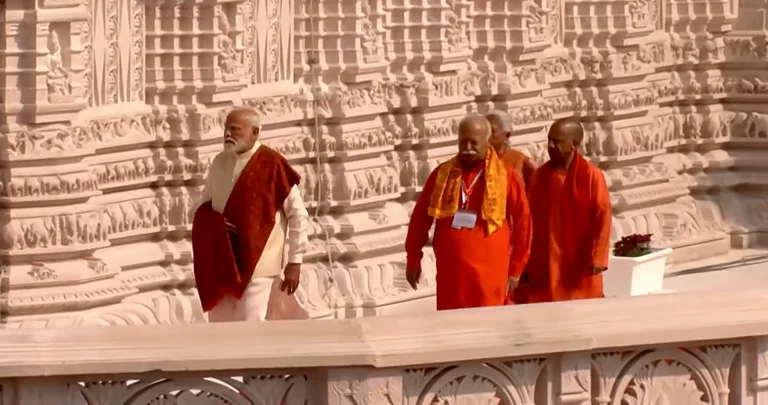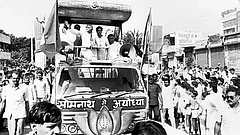Once simply a mound of land nourished by the Sarayu River and smaller streams, Ayodhya has seen its fate change repeatedly. For millions of devout Hindus, this mound is the birthplace of Lord Ram; for others, it is the posited birthplace of four of the first ten Tirthankars of Jains; yet others see this as the place where the Buddha is believed to have preached from; or identify it as the mazaar of Hazrat Sheesh Paigambar, the dargah of Badi Bua, revered as Ayodhya’s patron Sufi saint. As the religious dominates all understanding of Ayodhya today, what do we truly know about its pre-modern history?
Around the fifth century BCE, in the kingdom of Kosala lay a busy town at the intersection of two major routes: one going from Sravasti in the north to Pratishthana in the south, and the other going to Taxila in the west from Rajagriha in the east. This town was called Saket. King Prasenjit ruled it from his capital, Sravasti, about 80 kilometres from Saket. Prasenjit is also known as the king of Kosala, which is acknowledged to be another name for Ayodhya.
As trade flourished in the region, Saket came to be coveted by the neighbouring kingdoms of Kashi (Banaras) and Magadha. The Magadha king Ajatashatru annexed Saket and it remained a part of the Magadha Empire until its fall in 200 BCE. Although Saket remained a business centre for 300 years (485–200 BCE) it never grew as a political centre. However, it continued to attract to its bounteous gardens preachers like the Buddha and Mahavira, who proselytised there.
Saket and Ayodhya
Was Saket located in present-day Ayodhya? We cannot conclusively state that, but we do know Saket had become a large and important city in the time of the Buddha, as is evidenced by accounts of his several visits there. Scholars say that the Buddha lived in the sixth century BCE. Historians Thakur Prasad Varma and Swaraj Prakash Gupta in their book, Ayodhya ka Itihaas evam Purattatva (Ayodhya’s History and Archaeology) published by the Indian History and Culture Society in 2001, claim that ‘‘the places at which the Buddha resided in Saket include Ajjanayan and Tikandivan and Kalakarma, a hostel for the Buddha’s students, which was situated in Saket and where he stayed.” Even though many historians—and several texts—attest to Saket and Ayodhya being one and the same place, there is no consensus on it.
Ram Emerges as a Political Tool
With the passing of time and the coming of new rulers the legend of Saket and Ayodhya being one grew stronger. The Gupta ruler Skandagupta (skanda means spilling or spurting, a likely allusion to bloodshed) was a prolific conqueror who succeeded Kumaragupta I and presided over the Gupta Empire from 455–467 CE. It is also believed that during the time of the Guptas there was a Brahmanical revival and the town of Saket reacquired prominence.
Skandagupta is said to have moved the capital of the Guptas from Pataliputra (Patna) to Saket. He awarded himself the title of ‘Vikramaditya’ (stronger than the sun). According to Hans Bakker “...the vanquisher of the Hunas (the name given to Central Asian tribes), Skandagupta, liked to compare himself with Ram and the choice of Saketa as the new capital might have offered a good opportunity to invigorate the ideology of his power. The restoration of the capital of yore, the renascence of the glory of Iksvaku, was a theme that was prominent in circles attached to the Gupta court of this time.”
Buddha’s Legacy, Ram Rajya and Ayodhya
Ascending anachronism means pushing an event or occurrence to a time in the past. This is often accompanied by the idealisation of that time as a perfect period. The more the event is pushed back into the past, the more legitimising power it acquires. Hindus today are told that in the time of the King God Ram, Ayodhya was the ideal, a capital where all lived happily and peacefully. In the modern period too, the example of Ram rajya, or Ram’s rule, was often cited by Mahatma Gandhi. It is interesting that Gandhi could use Ram rajya to galvanise all communities and not just Hindus, which reflects the plurality of the Ramayana tradition. It is also important to note that Ram was called Imam-e-Hind by Iqbal—the famous Urdu poet. But it is impossible to establish when Ram rajya prevailed, if it indeed did.
The Paucity Of Evidence Of The Kingly Ram Has Been Replaced By Faith In The Godly Ram, And Thus, The Ayodhya Of Today Encapsulates Both Ram Rajya And Ram Worship.
The paucity of evidence of the kingly Ram has been replaced by faith in the godly Ram, and thus, the Ayodhya of today encapsulates both Ram rajya and Ram worship.
The Buddha is believed to have preached from Mani Parbat, a mound of earth on the periphery of Ayodhya. Today, Mani Parbat has been encapsulated in local Ramayana lore. It is said to be a fallen portion of the hill that contained the Sanjeevani herb, which Hanuman transported from the Himalayas to the battlefront in the war against Ravan. Deshraj Upadhyay, a local expert on the region’s history explains the origins of the Mani Parbat tale: “When the Buddha visited Saket (Ayodhya), he used to stay in Pubbaram Vihar which is the Pali distortion of Purvaram Vihar (earlier it was called Ram’s Vihar). Thus it is clear that the place was associated with Ram in the time of the Buddha. Later on, in the time of Nandaram of the Krishna dynasty, a small stupa was built there which was enlarged during Ashoka’s rule. With the decline of Buddhism, the hump was abandoned by Hindus till the Vaishnava tradition turned it into a Ramayanic spot in the Mughal era.”
This kind of appropriation by the Vaishnava tradition is also seen in the case of the oldest known temple in Ayodhya—the Nageshwarnath temple on the banks of the Sarayu. A guide’s version of its history goes like this: “This temple is dedicated to Shiva and the Shivling there is said to have been installed by Kush, Ram’s son, as a sign of gratitude to a Naga kanya who helped him find his bangle which had fallen in the Sarayu.” The guides, mostly from the community of Pandas, are young boys who work part-time to promote this hybrid but indisputably Vaishnava history of Ayodhya. They are aware of Ayodhya’s Buddhist history but reluctant to acknowledge it. Some of them admit that being untrained in history, they are unqualified to comment on any non-Hindu aspect of the region. Many of these guides were, in fact, born after the Babri Masjid was demolished in 1992. Thus, to them, Ayodhya is what the Vishva Hindu Parishad has made it out to be. However, many people acknowledge that Ram worship in Ayodhya is a phenomenon that gained prominence in the Mughal period (1526–1857).
Amir Khusrau Goes to Ayodhya
The last known Hindu king who ruled Ayodhya was Govindchandra Gahadavala in the eleventh century CE, after which it came under the rule of various Muslim kingdoms, and remained so till the advent of British rule in the 1800s. In 1246 CE, Malk-i-Jahan, the mother of Emperor Nasiruddin Mahmud, relinquished all power and chose to spend the rest of her life amidst the serenity of Ayodhya, which was famous for its gardens and spiritual solace. This beauty did not escape the notice of Amir Khusrau, ‘‘the Parrot of Hindustan’’, either.
In 1287 CE, Amir Khusrau joined the service of a noble in Balban’s court with whom he moved to Ayodhya. Khusrau wrote to his unnamed friend with longing and shared stunningly real descriptions of his new home’s natural beauty:
“What a town! Nay it is not a town; it is all a great garden.
It does not possess much but is so rich with inner peace.
It is a town which adorns the good earth.
Its suburbs call out to you, go free!
The blissful stream running under its feet quench
One; wayfarers thirst through the eyes.
Happiness here knows no bounds; every leaf and
every flower, pours out nectar-eternal…”
Ayodhya Under the Lodis and the Mughals
Bahlul Lodi ascended the throne of Delhi in 1451 CE, appointing his nephew Muhammad Farmuli as the governor of Awadh in 1489 CE. The Farmulis would be the de facto rulers of Ayodhya from 1489 CE until the defeat of their Lodi masters by Babur in the Battle of Panipat in 1528 CE. After that battle, Bayazid Farmuli, a descendant of Muhammad Farmuli, was reappointed as the chief of Awadh by Babur. Here, the narrative begins to blur. Did Babur come to Ayodhya at all? Did he order the destruction of a temple and have a mosque built in its place? Historians have always differed on this point. In 2019, the Supreme Court judgement accepted there is no evidence to conclude that Babur had the mosque built or that there was a Ram temple that was demolished on his orders.
Akbar’s reign (1556–1605) stimulated religious life in his empire, which spanned most of north India. Besides Islam and the various sects under it, among Hindus, Krishna worship and Ram worship too grew under Akbar’s direct and indirect patronage. Many new temples were constructed by his Hindu chiefs and officials. A case in point being the Govinda Deva temple at Vrindavan, which was built by Raja Man Singh of Amber in 1590 during Akbar’s reign.
Did Babur Come To Ayodhya At All? Did He Order The Destruction Of A Temple And Have A Mosque Built In Its Place? Historians Have Always Differed On This Point.
Ayodhya had by the 1700s become an important religious place for Muslims too. Several Sufis had roots in the province and Ayodhya itself had become associated with the legends of prophets Shish, Nuh and Ibrahim. Scores of other Sufi saints like Shah Madar, Badi Bua and Nasiruddin Chirag Dehlavi had found both a temporal and a spiritual home in Ayodhya.
Ganga-Jamuni Culture
After the death of the first Hindu governor Chabile Ram in 1719 CE, his nephew Girdhar Bahadur was appointed governor. It is believed that under him and through the urging of Jai Singh II of Jaipur, a Vaishnava revival started in Ayodhya. For Ayodhya’s evolution as a place of Ram worship, a decisive change happened in 1722 CE when Mughal emperor Muhammad Shah appointed his minister Mir Muhammad Khan the governor of Awadh. Mir Muhammad Khan adopted the title of ‘Saadat Khan’ and built the Qila Mubarak, a small fortress that afforded a clear view of River Sarayu and beyond. According to tradition, it was in Saadat Khan’s time that the first land grants to Ramanandi akharas were made. Adopting a generous and accommodating attitude towards the Ramanandi ascetics, Saadat Khan permitted his diwan, Dayashankar, to support the construction of both Shaiva and Vaishnava temples. His army still relied on Shaiva warriors in battles. In the course of history the ruins of his fort, known as Lakshman Qila today, were occupied by Ramanandis.
Ayodhya’s Patron Aunt: Badi Bua
A grove of neem, tamarind and banyan trees shrouds the tomb of Ayodhya’s most revered aunt. Popularly known as Badi Bua (father’s elder sister) or Badi Bibi, her tomb draws a stream of committed followers throughout the year. In the annual urs (death anniversary) held in her memory, thousands gather to commemorate the piety and seek the blessings of Badi Bua, the older sister of the Sufi saint Nasir-ud-din ‘‘Chiragh-e-Dehlavi’’. Her followers have an interesting anecdote to share, which displays her singular dedication to God. Badi Bua was troubled by the mullahs for remaining unmarried. They confronted her and insisted that she must follow the customs of Islam and get married. She agreed but insisted she would only marry ‘‘a truly pious man’’. The kotwal (chief police officer) of Ayodhya sent a messenger to Badi Bua expressing his interest in marrying her. She demanded that the kotwal present himself in person. Badi Bua asked the kotwal why he wished to marry her and when he said that ‘‘he was in love with her eyes”, she gouged out her eyes and gave them to him. The kotwal was so shaken that he fell at her feet and begged for forgiveness.
For the residents of Ayodhya, there are three main goddesses: Choti Dev Kali in Ayodhya, Badi Dev Kali in Faizabad and this dargah of Badi Bua. They worship here because these goddesses protect Ayodhya and its people. In Ayodhya, one can see Muslim women praying at Kanak Bhavan; they also go to Choti Dev Kali—they may not go inside the temple, but they stop outside it and pray. This is the Ayodhya where the sounds of temple bells and conches merge with that of the muezzin’s azaans. The silent, invisible, poor and peaceful section of Ayodhya.
Much of Ayodhya’s history remains shrouded in darkness and therefore myths, growing more vitriolic in nature, are generally thrown up to fill the blanks. But, clearly, it is the rich and versatile histories of this region that sustain the famed Ganga-Jamuni syncretic culture of Awadh. As the wheel of time turns, one hopes that this present period of toxic majoritarianism will prove to be short-lived and fraternity will prevail over intolerance and hatred. As Khusrau wisely said:
Kaafire ishq ishqam muslamani mara darkaar neest
Har range man tare gashta haazate junnar neest
(I am the worshipper of love, I don’t need to be a Muslim
My rags are the thread, I don’t need the sacred thread.)
MORE FROM THIS ISSUE
(Views expressed are personal)
Valay Singh is the author of Ayodhya: City Of Faith, City Of Discord





























